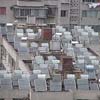 |
Moscow (AFP) Aug 8, 2006 Russia is risking accidents by pumping increased amounts of oil through its ageing pipeline system, the world's largest, experts and campaigners warned this week after BP shut down the largest oil field in the United States because of pipeline corrosion. "The pipeline network is certainly very old, and a lot of the regional pipeline network was built during Soviet times when standards were not as good as they are now," said Chris Weafer, chief analyst at Alfa Bank. The system will come under increasing strain as state-controlled oil companies such as Rosneft and Gazpromneft look to boost production and export growth to take advantage of record-high prices, Weafer said. "The old pipeline networks are going to be coming under a lot more pressure to carry a lot more oil inside Russia and to the export market." With the additional pressure, "there will be more leaks. I think that's inevitable," Weafer said. Russia has more than 69,000 kilometres (43,000 miles) of trunk and auxiliary pipelines, according to figures from Russia's transport monopoly Transneft. The world oil market is already under strain due to the conflict in the Middle East and unrest in Nigeria, making prices sensitive to any fall-off in production. BP's shutdown of the Prudhoe Bay oil field in Alaska, which could reduce US oil output by eight percent, has caused world crude prices to surge to around record high levels. "Any accident that leads to oil demand not being met means prices will rise," said Andrei Gromadin, oil and gas analyst at MDM Bank in Moscow. The most serious potential accident in Russia would involve the main pipelines that ship Russian crude from oil fields in Siberia to refineries in western Russia and on to Europe, Gromadin said. Last month, a rusted pipe in Russia's largest export pipeline burst, spilling about 100 tonnes of oil in Russia's western Bryansk region. Oil prices spiked briefly after officials made the spill public. But exact figures on the number of pipeline bursts and oil spills each year in Russia are difficult to find because of a lack of official sources, said Ivan Blokov, environmental campaign director for Greenpeace Russia. "The government tries in every way to limit access to information," Blokov said. "That's not the official position, but that's the reality." Blokov estimated that between 10 million and 20 million tonnes of oil were spilled in Russia each year, and said that in 2003, the last time reliable figures were available, more than 20,000 pipeline bursts were recorded. "The situation with Russia's oil pipelines was fairly close to catastrophe, and it still is," Blokov said.
Source: Agence France-Presse Community Email This Article Comment On This Article Related Links Powering The World in the 21st Century Powering The World in the 21st Century at Energy-Daily.com
 Beijing (AFP) Aug 11, 2006
Beijing (AFP) Aug 11, 2006The southern boomtown of Shenzhen has set an example for power-hungry Chinese cities in energy saving by mandating the use of solar power in new housing construction, state media reported Friday. |
|
| The content herein, unless otherwise known to be public domain, are Copyright 1995-2006 - SpaceDaily.AFP and UPI Wire Stories are copyright Agence France-Presse and United Press International. ESA PortalReports are copyright European Space Agency. All NASA sourced material is public domain. Additionalcopyrights may apply in whole or part to other bona fide parties. Advertising does not imply endorsement,agreement or approval of any opinions, statements or information provided by SpaceDaily on any Web page published or hosted by SpaceDaily. Privacy Statement |